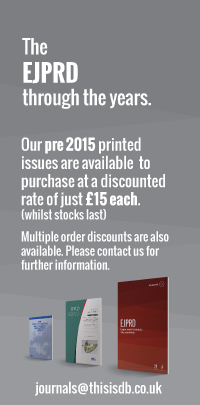Does Impression Material Thickness Impact the Accuracy of Addition Silicone Impressions and the Resultant Casts? A 3D Analysis
- Page Start
- 0
- Page End
- 0
- D.O.I.
- 10.1922/EJPRD_2795Negm17
- Enas E. Negm
- Mangala Patel
- Paul Ryan
Abstract
Objectives: Conflicting evidence exists regarding the optimal impression thickness and the influence of tray spacing on the accuracy of elastomeric impressions and resulting casts. This study evaluated the effect of three tray spacings (2 mm, 4 mm, and 6 mm) on the dimensional accuracy of three addition silicone impression materials (Aquasil, Panasil, and Elite-HD). Methods: Forty-five impressions of a partially dentate maxillary resin cast were made using standardized custom trays with designated spacer thicknesses. Impressions were scanned using a desktop scanner, and casts were poured into type IV dental stone and subsequently scanned. A digital reference cast was generated and used to superimpose all test scans. Deviations were measured across the full arch, palate, and dentulous-edentulous (horseshoe) regions using digital metrology software. Data were analyzed using multiple regression and Tukey HSD post-hoc tests (α = 0.05). Results: Spacer thickness and material significantly influenced impression and cast accuracy, with higher deviations observed in the horseshoe region compared to the palate (p < 0.001). Conclusions: Panasil at 6-mm spacing produced the most accurate impressions across all regions. Clinical relevance:For cast accuracy, Elite-HD at 4-mm spacing showed the lowest deviation in the palate, while Panasil at 2-mm spacing demonstrated superior accuracy in both full arch and horseshoe regions.
Keywords
3D Analysis
Addition Silicone
Gypsum
Tray Spacer
Partially Dentate
Dental Impression

